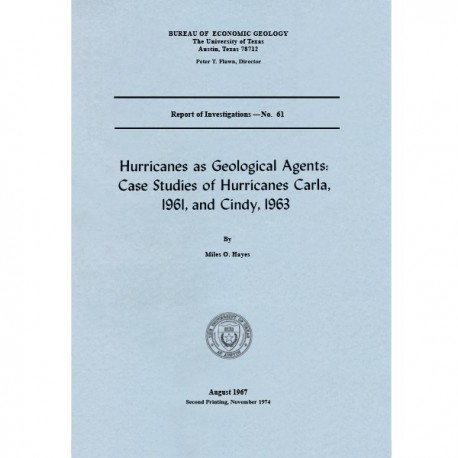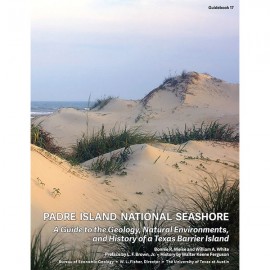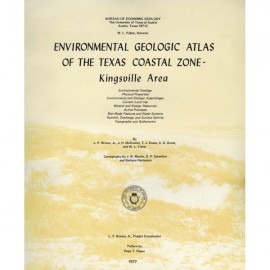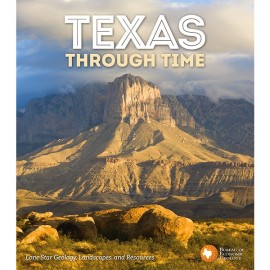Reports of Investigations
-
Books & Reports
- Reports of Investigations
- Guidebooks
- Udden Series
- Geological Circulars
- Down To Earth
- Atlases of Major Oil and Gas Reservoirs
- Texas Memorial Museum Publications
- Environmental Geologic Atlas of the Texas Coastal Zone
- Mineral Resource Circulars
- Other Reports
- Seminars and Workshops
- Handbooks
- Submerged Lands of Texas
- Symposia
- Annual Reports
- Open File Reports
-
Maps & Cross Sections
- Thematic Maps
- Miscellaneous Maps, Charts & Sections
- Geologic Atlas of Texas
- STATEMAP Project Maps
- Geologic Quadrangle Maps
- Cross Sections
- Highway Geology Map
- Energy and Mineral Resource Maps
- Shoreline Change and Other Posters
- Wilcox Group, East Texas, Geological / Hydrological Folios
- Bouguer Gravity Atlas of Texas
- River Basin Regional Studies
- Featured Maps
- Posters
- Teachers & the Public
-
Geological Society Publications
- Gulf Coast Association of Geological Societies
- Alabama Geological Society
- Austin Geological Society
- Corpus Christi Geological Society
- Houston Geological Society
- Lafayette Geological Society
- Mississippi Geological Society
- New Orleans Geological Society
- South Texas Geological Society
- GCS SEPM Publications
- Historic BEG & UT Series
Hurricanes as Geological Agents: Case Studies of Hurricanes Carla, 1961, and Cindy, 1963
RI0061
Hurricanes as Geological Agents: Case Studies of Hurricanes Carla, 1961, and Cindy, 1963, by M. O. Hayes. 56 p., 30 figs., 1967. ISSN: 0082335X: Print Version.
A free, digital version of this publication can be found on: Texas ScholarWorks
RI0061. Hurricanes as Geological Agents: Case Studies of Hurricanes Carla, 1961, and Cindy, 1963, by M. O. Hayes. 56 p., 30 figs., 1967. ISSN: 0082335X: Print.
To purchase this publication as a downloadable PDF, please order RI0061D.
ABSTRACT
Tropical storms, which cross the Texas coastline with a frequency of 0.67 storms per year, play a major role in nearshore sedimentation on the south Texas coast. Greatest geological effects of these storms are produced by wind-driven waves and by storm surges.
The comparison of a part of the nearshore environmental complex of a segment of the south Texas coast before and after hurricane Carla, 1961, shows the effects of the storm. The bottom of the inner neritic zone was both a contributor and a receiver of hurricane deposits. As the storm moved landward, it picked up mollusc shells, rock fragments, coral blocks, and other materials from depths as great as 50 to 80 feet and deposited them on the barrier island. After the storm passed inland, strong currents spilled out of the numerous hurricane channels cut into the island by the storm-surge flood. These currents deposited a thin layer (0.5 to 1.5 inches) of sand over what was previously sandy mud bottom out to depths of 60 feet and a graded layer of fine sand, silt, and clay (a turbidite) farther out on the shelf. The storm removed a belt of foredunes 20 to 50 yards wide from the seaward side of Padre Island and left the foredune ridge with wave-cut cliffs up to 10 feet high. The formation of a broad, flat hurricane beach drastically altered the beach profile. The landward side of the barrier island (wind-tidal flats) received much washover material containing surf zone and beach molluscs. The storm also submerged high-level mud flats along the landward side of Laguna Madre and covered them with a fresh layer of mud. A much milder storm (Cindy) passed through the area in September 1963, and a small swash bar was deposited over the seaward edge of the pre-existing hurricane beach.
Some important stratigraphic implications of these observations include: (a) Hurricanes can mix environment-sensitive faunas from a variety of environments into a single sedimentary deposit; (b) hurricanes can play a primary role in sediment transport in nearshore environments; (c) hurricanes displace sedimentary processes such that sediment textures and structures normally related to a particular process (e.g., fluvial channel flow) may occur in alien areas; and (d) a great deal of energy is expended sporadically in nearshore environments rather than in a uniform, constant manner.
Keywords: tropical storms, hurricanes, Texas coast, Padre Island, beaches, nearshore, Cindy, Carla
Citation
Hayes, M. O., 1967, Hurricanes as Geological Agents: Case Studies of Hurricanes Carla, 1961, and Cindy, 1963: The University of Texas at Austin, Bureau of Economic Geology, Report of Investigations No. 61, 56 p.





